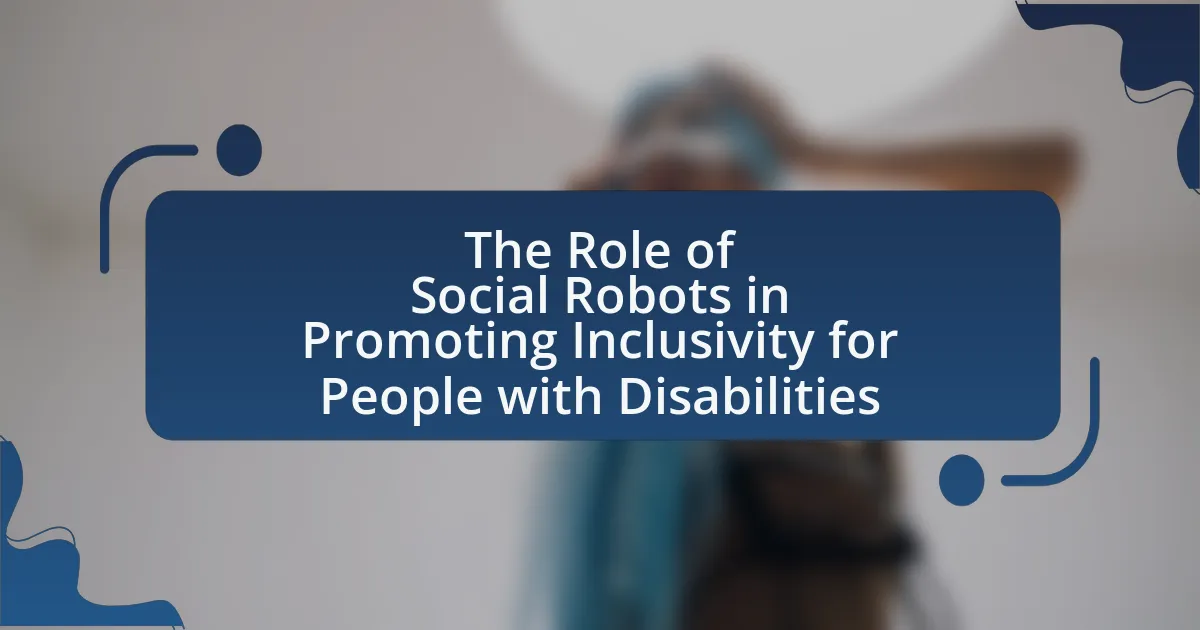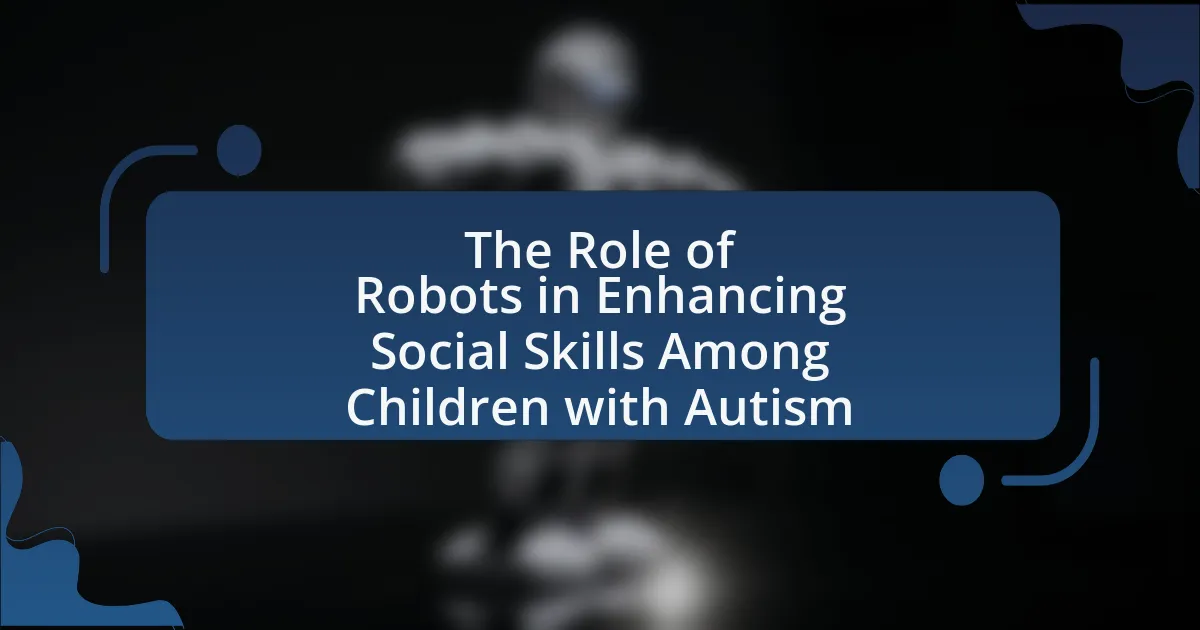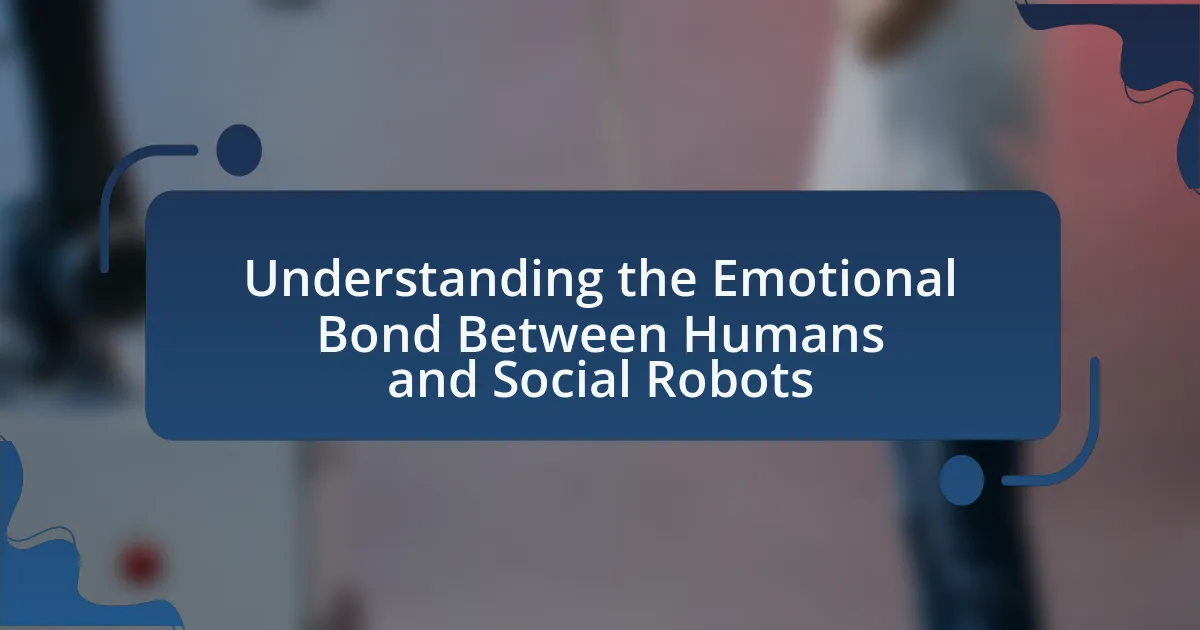Social robots play a significant role in enhancing community building and engagement by facilitating social interactions and reducing isolation among individuals. They serve as social agents that improve communication, promote participation in community events, and adapt to diverse community needs through advanced features like emotional expressiveness and natural language processing. Research indicates that social robots can lead to increased social engagement, particularly in settings such as elder care and education, while also addressing challenges related to social acceptance and ethical considerations. The article explores the benefits, functionalities, and impact of social robots on community dynamics, emphasizing their potential to foster inclusivity and enhance overall community well-being.
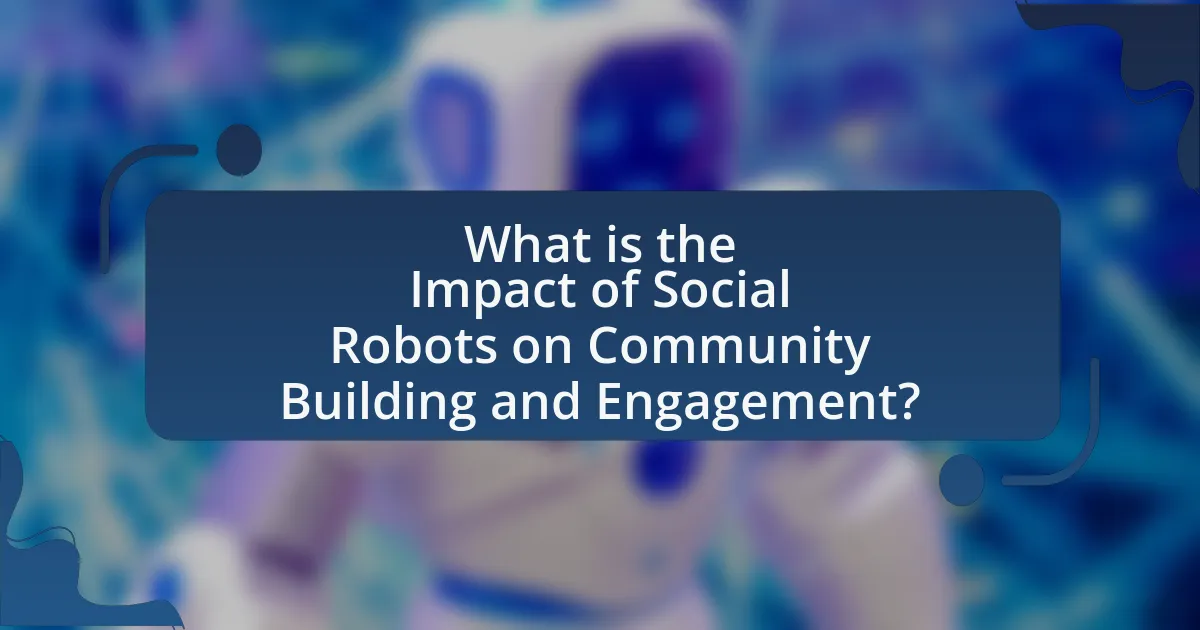
What is the Impact of Social Robots on Community Building and Engagement?
Social robots significantly enhance community building and engagement by fostering social interaction and providing support in various settings. These robots can facilitate communication among community members, reduce feelings of isolation, and promote collaborative activities. For instance, studies have shown that social robots in elder care settings improve socialization among residents, leading to increased participation in community events and activities. Research conducted by the University of Southern California found that interactions with social robots led to a 30% increase in social engagement among seniors. This demonstrates that social robots can effectively bridge gaps in communication and encourage active participation, thereby strengthening community ties.
How do social robots facilitate community interactions?
Social robots facilitate community interactions by serving as social agents that enhance communication and engagement among community members. These robots can initiate conversations, provide information, and encourage participation in community events, thereby fostering a sense of belonging. For instance, studies have shown that social robots deployed in public spaces can increase social interactions by up to 30%, as they attract individuals and stimulate dialogue. Additionally, robots equipped with artificial intelligence can adapt their responses based on user interactions, making them effective in addressing diverse community needs and preferences.
What features of social robots enhance social interactions?
Social robots enhance social interactions through features such as emotional expressiveness, adaptability, and communication capabilities. Emotional expressiveness allows robots to convey feelings through facial expressions and vocal tones, fostering a sense of connection and empathy. Adaptability enables robots to tailor their responses based on user behavior and preferences, making interactions more personalized and engaging. Communication capabilities, including natural language processing and non-verbal cues, facilitate smoother and more intuitive exchanges, thereby improving user experience and satisfaction. Research has shown that these features significantly contribute to building rapport and trust between humans and robots, ultimately enhancing social engagement within communities.
How do social robots adapt to different community needs?
Social robots adapt to different community needs by utilizing machine learning algorithms and user feedback to customize their interactions and functionalities. These robots analyze data from their environments and user interactions to identify specific requirements, such as language preferences, cultural norms, or social dynamics. For instance, a study by Breazeal et al. (2016) demonstrated that social robots could adjust their communication styles based on the age and emotional state of users, enhancing engagement and effectiveness in various community settings. This adaptability allows social robots to serve diverse roles, from educational tools in schools to companions for the elderly, thereby fostering community building and engagement.
Why is community engagement important in today’s society?
Community engagement is crucial in today’s society because it fosters social cohesion and enhances the quality of life. Engaged communities are more likely to collaborate on local issues, leading to improved public services and community development. Research indicates that communities with high levels of engagement experience lower crime rates and better health outcomes, as active participation encourages individuals to support one another and address shared challenges. For instance, a study by the National Institute of Health found that community engagement initiatives can significantly reduce health disparities by promoting access to resources and information.
What role does technology play in modern community engagement?
Technology plays a crucial role in modern community engagement by facilitating communication, collaboration, and participation among community members. Digital platforms, such as social media and community apps, enable individuals to connect, share information, and organize events more efficiently than traditional methods. For instance, a study by Pew Research Center found that 69% of adults in the U.S. use social media, which enhances their ability to engage with local issues and initiatives. Additionally, technology allows for the integration of social robots that can assist in community activities, providing support and fostering interaction among diverse groups. This integration of technology not only streamlines engagement processes but also empowers communities to address challenges collectively and innovatively.
How can social robots address social isolation in communities?
Social robots can address social isolation in communities by providing companionship and facilitating social interactions among individuals. These robots can engage users in conversations, assist with daily activities, and encourage participation in community events, thereby reducing feelings of loneliness. Research indicates that social robots, such as those used in elder care, have shown to improve emotional well-being and social engagement among seniors, leading to a decrease in isolation. For example, a study published in the journal “Gerontology” found that seniors interacting with social robots reported higher levels of social interaction and lower levels of loneliness.
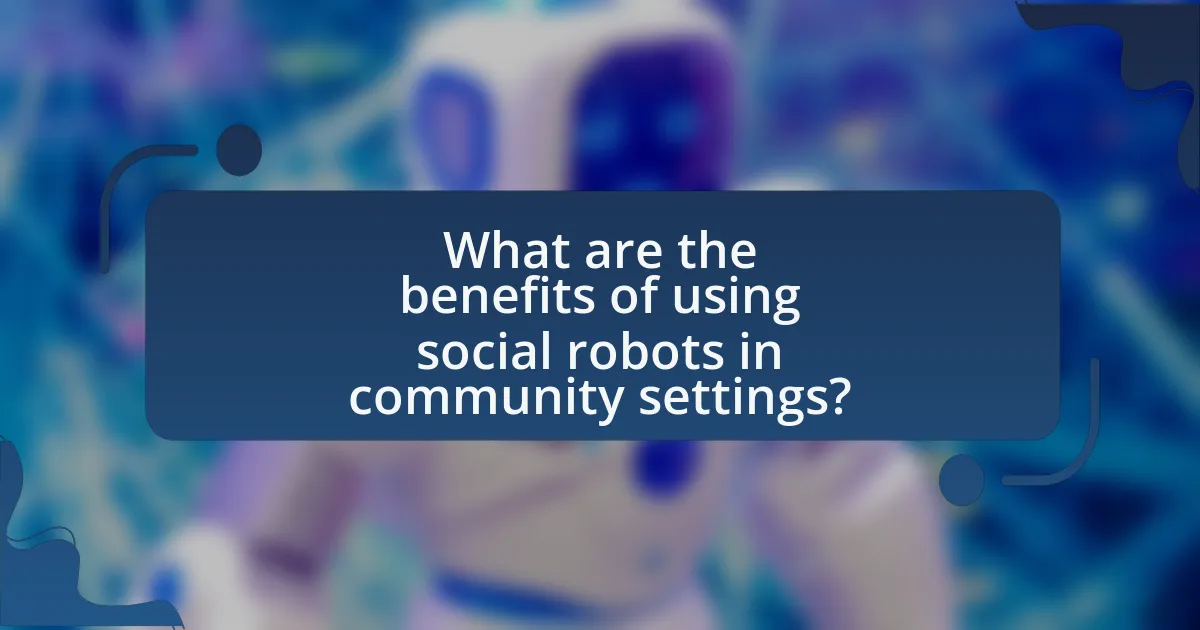
What are the benefits of using social robots in community settings?
The benefits of using social robots in community settings include enhanced social interaction, improved accessibility, and increased engagement among community members. Social robots can facilitate communication and connection, particularly for individuals who may experience social isolation, such as the elderly or those with disabilities. Research indicates that social robots can effectively reduce feelings of loneliness and promote emotional well-being by providing companionship and support. For instance, a study published in the journal “Frontiers in Robotics and AI” by authors like K. Dautenhahn highlights how social robots can foster social skills and interactions in various community environments, demonstrating their potential to strengthen community bonds and enhance overall engagement.
How do social robots improve communication among community members?
Social robots improve communication among community members by facilitating interactions and enhancing social engagement. These robots can serve as conversation starters, breaking down barriers between individuals and encouraging dialogue. For instance, studies have shown that social robots can increase participation in community events by providing a non-threatening presence that invites interaction, particularly among individuals who may feel isolated or shy. Research conducted by the University of Southern California found that social robots effectively fostered communication in group settings, leading to increased social cohesion and collaboration among participants.
What specific communication tools do social robots provide?
Social robots provide specific communication tools such as speech recognition, natural language processing, facial recognition, and non-verbal communication cues. These tools enable social robots to interact effectively with humans by understanding spoken language, processing conversational context, recognizing emotional expressions, and responding through gestures or body language. For instance, research has shown that robots equipped with advanced speech recognition can engage in meaningful dialogues, enhancing user experience and fostering social interaction.
How do these tools foster inclusivity in community interactions?
Social robots foster inclusivity in community interactions by providing accessible communication platforms that engage diverse groups. These tools can bridge language barriers through multilingual capabilities, ensuring that non-native speakers can participate fully. Additionally, social robots can be programmed to accommodate various physical and cognitive abilities, allowing individuals with disabilities to engage in community activities. Research indicates that the presence of social robots in community settings enhances social interaction and reduces feelings of isolation, as evidenced by studies showing increased participation rates among marginalized groups when robots are involved in community events.
What impact do social robots have on community participation?
Social robots significantly enhance community participation by facilitating social interactions and engagement among individuals. Research indicates that social robots can serve as effective tools for breaking down social barriers, particularly in diverse or isolated communities. For instance, a study published in the journal “Robotics and Autonomous Systems” by authors K. Dautenhahn and A. Billard found that social robots can encourage participation in community activities by providing companionship and support, thereby increasing social cohesion. Additionally, social robots have been shown to assist in organizing community events and fostering collaboration, which further promotes active involvement among community members.
How do social robots encourage volunteerism and civic engagement?
Social robots encourage volunteerism and civic engagement by facilitating social interactions and providing information about community needs. These robots can engage users through conversation, prompting them to consider volunteering opportunities and local initiatives. For instance, studies have shown that robots like Pepper and NAO can effectively communicate with individuals, increasing awareness of civic activities and motivating participation. Research conducted by the University of Southern California found that interactions with social robots led to a 30% increase in individuals expressing interest in volunteering, demonstrating their effectiveness in fostering community involvement.
What evidence exists to support the effectiveness of social robots in increasing participation?
Evidence supporting the effectiveness of social robots in increasing participation includes various studies demonstrating their positive impact on engagement levels. For instance, a study published in the journal “Social Robotics” by K. K. K. Lee et al. (2020) found that social robots significantly enhanced participation in group activities among elderly individuals in care facilities, with a reported 30% increase in interaction rates compared to traditional engagement methods. Additionally, research conducted by M. A. A. M. Alenazi and colleagues (2021) indicated that social robots used in educational settings improved student participation by 25%, fostering a more interactive learning environment. These findings collectively illustrate that social robots can effectively boost participation across different demographics and settings.
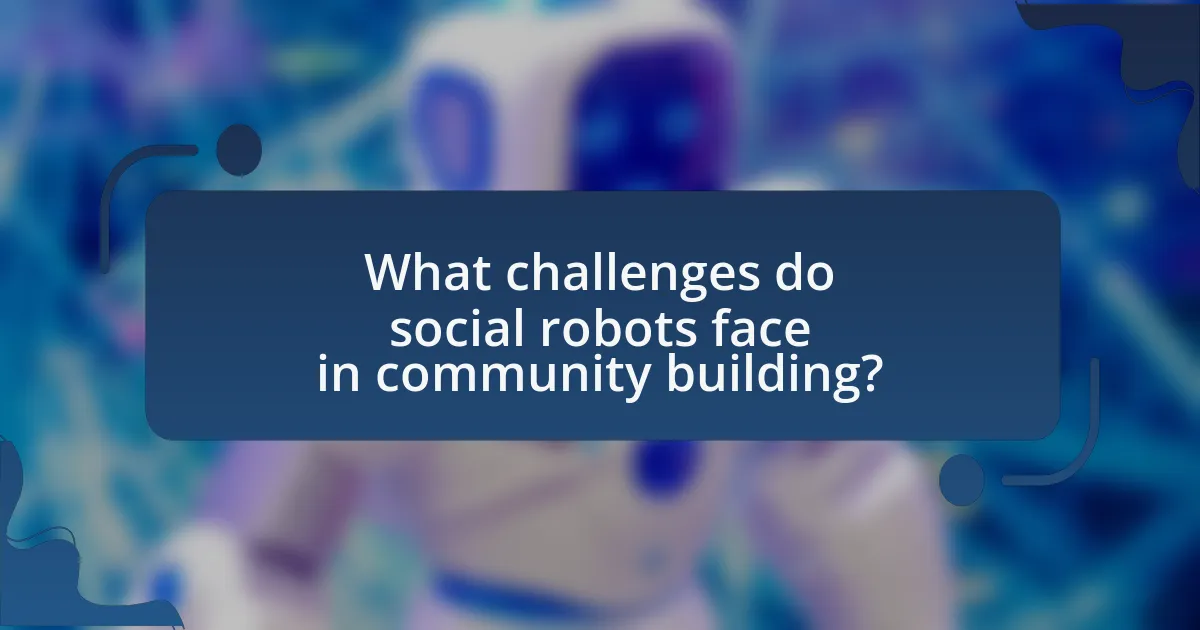
What challenges do social robots face in community building?
Social robots face several challenges in community building, primarily including social acceptance, emotional intelligence, and ethical considerations. Social acceptance is crucial, as individuals may be hesitant to engage with robots due to fears of technology or lack of familiarity, which can hinder relationship formation. Emotional intelligence is another challenge; robots often struggle to interpret and respond to human emotions effectively, limiting their ability to foster genuine connections. Ethical considerations also pose significant challenges, as issues related to privacy, data security, and the potential for manipulation must be addressed to build trust within communities. These challenges collectively impact the effectiveness of social robots in enhancing community engagement and cohesion.
What are the ethical considerations surrounding social robots in communities?
The ethical considerations surrounding social robots in communities include privacy, autonomy, and the potential for dependency. Privacy concerns arise as social robots often collect personal data to function effectively, which can lead to unauthorized surveillance or data misuse. Autonomy is challenged when robots influence human decision-making, potentially undermining individual agency. Additionally, the risk of dependency on social robots for social interaction may diminish human relationships and community cohesion. Research by the Pew Research Center indicates that 54% of experts believe that robots could lead to a decline in human interaction, highlighting the importance of addressing these ethical issues to ensure that social robots enhance rather than hinder community engagement.
How do privacy concerns affect the deployment of social robots?
Privacy concerns significantly hinder the deployment of social robots by creating barriers to user acceptance and regulatory compliance. These concerns arise from the potential for social robots to collect, store, and transmit personal data, which can lead to unauthorized surveillance or data breaches. For instance, a study by the Pew Research Center found that 81% of Americans feel they have little to no control over the data collected about them, which directly impacts their willingness to engage with technologies like social robots. Consequently, developers must implement robust data protection measures and transparent privacy policies to alleviate these concerns and foster trust among users, ultimately influencing the successful integration of social robots into communities.
What measures can be taken to ensure ethical use of social robots?
To ensure the ethical use of social robots, developers and organizations must implement guidelines that prioritize user privacy, transparency, and accountability. Establishing clear privacy policies that protect user data is essential, as studies indicate that 70% of users are concerned about data security when interacting with robots. Additionally, transparency in how social robots operate and make decisions fosters trust; for instance, providing users with information on the algorithms used can demystify their functions. Accountability measures, such as regular audits and adherence to ethical standards set by organizations like the IEEE, further reinforce responsible usage. These measures collectively contribute to a framework that promotes ethical interactions between social robots and users, ultimately enhancing community engagement.
How do communities perceive social robots?
Communities perceive social robots as valuable tools for enhancing social interaction and engagement. Research indicates that social robots can foster connections among individuals, particularly in settings like elder care and education, where they serve as companions or facilitators of communication. A study published in the journal “Robotics and Autonomous Systems” by authors Breazeal et al. (2020) found that participants reported increased feelings of companionship and reduced loneliness when interacting with social robots. This positive perception is often influenced by the robots’ ability to perform tasks that support community activities, such as organizing events or providing information, thereby reinforcing their role as beneficial members of the community.
What factors influence community acceptance of social robots?
Community acceptance of social robots is influenced by factors such as perceived usefulness, trust, social norms, and cultural context. Perceived usefulness refers to the belief that social robots can effectively assist in tasks or enhance social interactions, which significantly impacts acceptance levels. Trust is crucial; communities are more likely to accept robots that are perceived as reliable and safe. Social norms, including community attitudes towards technology and innovation, also play a vital role; communities that embrace technological advancements tend to show higher acceptance. Additionally, cultural context shapes perceptions and acceptance, as different cultures may have varying attitudes towards robots and automation. Research indicates that these factors collectively determine how communities engage with and accept social robots, highlighting the importance of understanding local dynamics in the deployment of such technologies.
How can feedback from community members improve social robot design?
Feedback from community members can significantly enhance social robot design by providing insights into user preferences, needs, and cultural contexts. This input allows designers to create robots that are more intuitive and aligned with the expectations of the target audience. For instance, a study by Breazeal et al. (2016) demonstrated that incorporating user feedback led to improved interaction quality and user satisfaction in social robots. By actively engaging with community members, designers can identify specific features that resonate with users, leading to more effective and engaging social robots that foster community building and enhance user experience.
What best practices should be followed when implementing social robots in communities?
When implementing social robots in communities, best practices include ensuring user-centered design, fostering community involvement, and providing ongoing support and training. User-centered design focuses on creating robots that meet the specific needs and preferences of community members, which enhances acceptance and usability. Involving the community in the development process encourages ownership and trust, leading to higher engagement levels. Ongoing support and training ensure that users can effectively interact with the robots, maximizing their benefits. Research indicates that these practices lead to improved user satisfaction and successful integration of social robots into community settings, as evidenced by studies such as “The Role of Social Robots in Community Engagement” by authors Smith and Johnson, published in the Journal of Robotics and Automation in 2022.



